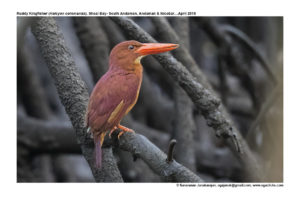Ruddy Kingfisher

Ruddy Kingfisher Halcyon coromanda
Etymology:
- Halcyon : Greekmythical bird which nested on the sea. It was loved by the gods, who calmed the waves whilst it incubated and raised its young.
- Coromanda: Coromandelicus : From Coromendal coast in India
Vernacular Names: Cachar: Dao natu gajao, Mar: Khandya, Hindi: Lal Kilkila
Distribution in India: Resident of Eastern Himalayan foothills, North East and Andaman & Nicobar Island in India.
Description: Size of 25–27 cm; male wt. is 73–80 g. It is a medium-sized, rather distinctive, but shy kingfisher. Both the sexes of nominate race have rufous-chestnut upperparts washed lilac, contrasting glossy azure-blue back and rump, paler rufous underparts. The bill is red or orange-red; iris is dark brown, orbital skin is red; legs and feet are scarlet. The juvenile is darker, duller and has dusky scallops on breast. The races vary in size, and in degree of violet or rufous coloration: race major is larger, paler than nominate, with less violet gloss, rump patch smaller; compared to latter, race bangsi differs in being darker, with smaller blue rump patch and more extensive purplish sheen to upperparts; race minor is very small, much darker, washed with violet, large silvery rump patch; race linae is darker; race mizorhina is dark rufous with bright violet gloss, dark below with violet wash on breast.
Habitat: It is found in North in temperate parts of range inhabits dense evergreen forest and temperate woodland around mountain streams at up to 1800 m, and cool, wet groves; in South tropical parts more often near coast in mangroves, Nipa palms and tidal forest, also streams in forest, secondary growth, woodland and coconut plantations with shrubby understorey. .It remains in cover during day, but may emerge in evening to bathe.
Food habits: When on land it eats insects, like beetles, grasshoppers and locusts, bugs, cicadas, butterflies, bees), , earthworms, land snails, and lizards. In aquatic habitats, it eats mayflies crabs and crayfish, frogs and tadpoles, newts and salamanders, fish, and offal. It obtains prey by watching from a perch and then flying down on to ground or diving into water or surf, returning to perch with prey.
Breeding habits: They breed in Jun in S Korea, in Jun–Jul in Japan; in Apr–May in India; in May in Southern Peninsular Malaysia, in Feb/Mar and May in North Borneo and in Feb–Mar in Sulawesi. The nest is dug in a steep earth bank or tree hole above ground or arboreal termitarium, old hornet nest, thatched roof and village mud walls are also used. The male excavates mainly in morning; entrance is concealed behind leafy vegetation. They lay a clutch of 4–6 eggs. Both the sexes incubate during day, but only female at night. Only the female broods the chicks. Both the sexes feed the young.